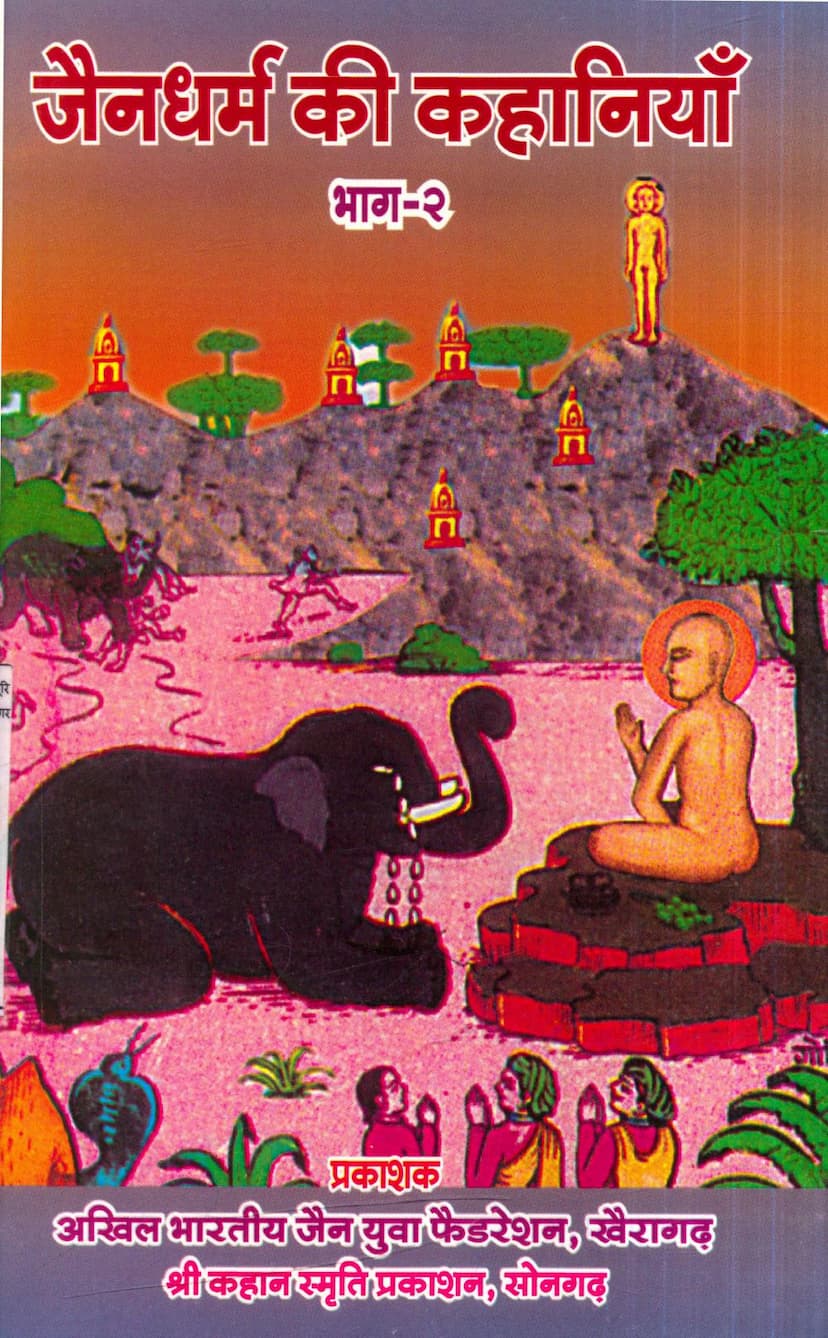Jain Dharm Ki Kahaniya Part 02
Added to library: September 1, 2025

Summary
This document is the second part of a Jain story collection titled "Jain Dharm Ki Kahaniya Part 02." It is published by Akhil Bharatiya Jain Yuva Federation and Shrikahan Smriti Prakashan. The book is dedicated to Shri Khemraj Gidiya and Shrimati Dhudhibai Gidiya, who established the Dhudhibai Khemraj Gidiya Granthamala in 1988 to publish religious literature and Puranic stories annually.
The book itself is the second offering of this Granthamala. It is authored by Brahmachari Haribhai Songadh, translated by Sou. Swarnalata Jain, and edited by Pandit Rameshchandra Jain Shastri. The publication aims to spread the spiritual revolution inspired by Gurudev Shri Kanji Swamiji.
Key Contents and Themes:
- Stories of Previous Lives (Bhavantar): The core of the book comprises 15 stories based on the past lives of religious figures. These stories aim to impart knowledge about detachment (vairagya) and spiritual understanding.
- Key Narratives Highlighted:
- The Second Lion's Story: This story, linked to Bharat Chakravarti's life, describes a lion's journey to spiritual realization after encountering a Muni.
- Discussion Between Two Wise Beings: This section features a conversation between a lion and an elephant who are destined to become future Tirthankaras (Mahavir and Parshvanath, respectively).
- Renunciation of Sagara Chakravarti and 60,000 Princes: This detailed narrative recounts how Sagara Chakravarti and his sons, through the guidance of a divine friend (Maniketu Dev), ultimately renounced worldly possessions and embraced monastic life.
- Vajrabahu's Renunciation: This story details how Prince Vajrabahu, inspired by the sight of a meditating Muni, renounced his worldly life, his marriage, and even his kingdom to become a monk, with his wife and brother-in-law also following suit.
- Sukausal's Renunciation: This story describes King Kirtidhar's (father of Sukausal) decision to renounce his kingdom after his son's birth, and how Sukausal himself, later influenced by his father's renunciation and encountering him as a Muni, also embraced monasticism.
- The Tigress's Renunciation: This narrative tells the story of Sahadevi, mother of Sukausal, who, due to her disrespect and criticism of ascetics, was reborn as a tigress. She eventually gained spiritual realization and attained a heavenly state after encountering her ascetic son.
- An Elephant: This story focuses on an elephant named Trilokmandal, who, after a significant encounter with Bharat Chakravarti, gained self-realization and embraced the path of a lay follower (Shravaka).
- Another Elephant's Autobiography: This story is narrated by another elephant, Vajraghosh (the soul of Marubhuti), who, after being killed by his brother Kamath, encountered Muni Arvind and attained Samyakdarshan and the knowledge of becoming the 23rd Tirthankara, Parshvanath.
- "When to Speak, What to Speak?": This section likely discusses the importance of judicious speech.
- Stories of Ahimsa Dharma: This section likely focuses on the principles of non-violence. King Shrenik, Queen Chellana, and Abhaykumar's past lives are recounted, highlighting the immense benefits of even partial adherence to Ahimsa.
- Anjana in the Forest: This story details how Anjana, abandoned and pregnant, found refuge and solace in the company of a Muni in a forest.
- Vira Hanuman, the Self-Aware Soul: This section focuses on Hanuman, son of Anjana, and his spiritual discussions with his mother, emphasizing the soul's true nature and the path to liberation.
- Hanuman's Vision of the Supreme Soul: This part describes Hanuman's experience of witnessing a Kevali (omniscient being) and the profound impact it had on him.
- Deshabhushan-Kulbhushan: This narrative recounts the story of two brothers, Deshabhushan and Kulbhushan, who, despite facing adversities and past karma, ultimately attained Kevalgyan.
- Emphasis on Renunciation and Spiritual Path: The overarching theme across these stories is the importance of detachment from worldly pleasures, the power of good company (Satsang), and the unwavering pursuit of the spiritual path leading to liberation (Moksha).
- Patronage and Support: The book acknowledges various individuals and trusts who have contributed financially to the publication, highlighting the collective effort in spreading Jain literature.
- Inspirational Figures: The text also pays tribute to inspirational figures like Brahmachari Harilal Mehta, a prolific writer and editor who dedicated his life to Jain literature.
In essence, "Jain Dharm Ki Kahaniya Part 02" is a collection of didactic stories from Jain scriptures and traditions, designed to educate and inspire readers about the principles of Jainism, particularly focusing on the virtues of renunciation, non-violence, and the ultimate goal of spiritual liberation.